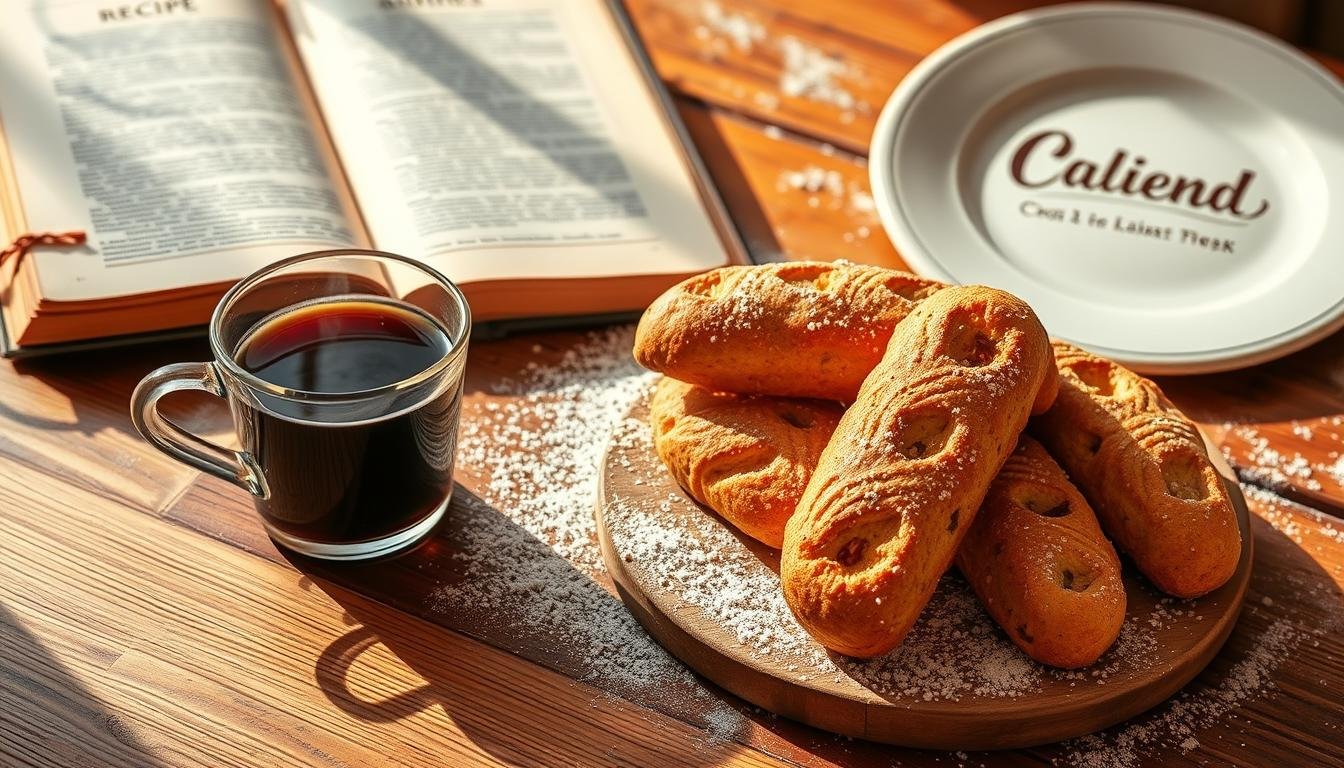We are excited to share with you Biscotti di Prato. It’s a classic treat from Italy that’s loved for centuries.
In Italy, biscotti are more than a sweet snack. They are a big part of the culture. People enjoy them with coffee or wine. Biscotti di Prato is famous for its crunchy texture and almond taste.
This article will tell you about the history and importance of traditional Italian baking. We’ll also give you a simple recipe to make Biscotti di Prato at home.
Key Takeaways
- Understanding the cultural significance of Biscotti di Prato in Italian culture.
- Learning the traditional Italian biscotti recipe.
- Discovering the importance of traditional baking methods.
- Getting a simple recipe to make Biscotti di Prato at home.
- Exploring the history behind Italian biscotti.
The Rich Heritage of Biscotti di Prato
Biscotti di Prato’s story is full of tradition, culture, and new ideas. This Italian cookie has been loved for centuries. It’s a big part of Italy’s food history.
Origins in Tuscany
Biscotti di Prato started in Tuscany, a place famous for great food and baking. Bakers in Prato, near Florence, made this cookie in the 14th century. They created a recipe for a cookie that lasts a long time.
Historical Significance in Italian Cuisine
Biscotti di Prato is very important in Italian food, especially on special days. It’s often eaten as a dessert or snack. People like to have it with Vin Santo, a sweet wine.
| Year | Event | Significance |
|---|---|---|
| 14th Century | Creation of Biscotti di Prato | Devised by bakers in Prato |
| 16th Century | Popularity Spreads | Became a staple in Italian bakeries |
| Present Day | Continued Tradition | Remains a beloved Italian treat |
What Makes Biscotti di Prato Unique
Biscotti di Prato is a special Italian treat. It’s made with traditional ingredients and old baking ways. This almond biscuit has been loved in Italian bakeries for a long time.
Traditional Ingredients
The ingredients in Biscotti di Prato make it special. Almonds give it a rich taste and crunchy bite. Other important things are high-quality flour, sugar, and eggs.
Some bakers add vanilla or lemon zest for extra flavor. Using high-quality almonds is very important for the biscotti’s taste.
| Ingredient | Importance |
|---|---|
| Almonds | Provide flavor and texture |
| High-quality flour | Ensures authentic texture |
| Sugar | Adds sweetness |
Distinctive Texture and Flavor Profile
The biscotti’s special texture comes from baking it twice. This makes the outside crunchy and the inside dry and cookie-like. The almond flavor makes it stand out.
“The twice-baking process is what gives biscotti their signature crunch,” notes baking expert, Giovanni Bianchi.
The flavor is also great because of the quality ingredients and baking method. So, Biscotti di Prato is loved not just in Italy but everywhere.
Essential Ingredients for Authentic Biscotti di Prato
The secret to making Biscotti di Prato is in its simple, top-notch ingredients. Each part plays a key role in making these Italian treats just right.
Flour Selection
Flour is key in making biscotti. You’ll need All-Purpose flour and Italian “00” flour.
All-Purpose vs. Italian00 Flour
All-Purpose flour is great for biscotti. It’s strong yet tender. Italian “00” flour is finer, making biscotti softer.
| Flour Type | Texture | Best For |
|---|---|---|
| All-Purpose | Moderate density | Classic biscotti texture |
| Italian “00” | Fine, delicate | Tender, crunchy biscotti |
Gluten-Free Alternatives
Need gluten-free biscotti? Use almond flour or gluten-free flour blends. But, they might change the taste and feel.
Nuts and Flavorings
Nuts are vital in Biscotti di Prato. They add texture and taste.
Traditional Almonds
Almonds are the go-to for Biscotti di Prato. They bring a deep, nutty flavor that pairs well with the biscotti’s crunch.
Alternative Nuts and Add-ins
While almonds are traditional, hazelnuts or pistachios can offer new tastes. Try adding dried fruits or chocolate chips too.
Quality Considerations
The quality of your ingredients matters a lot. Pick fresh, high-quality stuff for the best taste and texture in your Biscotti di Prato.
Kitchen Tools and Equipment You’ll Need
To bake Biscotti di Prato, you need the right tools. Having the right biscotti baking tools makes baking easier. It also makes your biscotti taste better.
Basic Baking Equipment
You’ll need basic baking stuff. This includes a big mixing bowl and measuring cups and spoons. You also need a baking sheet lined with parchment paper.
A mixing bowl big enough is key. It helps you mix without spilling. You’ll also need a baking sheet that can handle hot oven temperatures.
Optional Specialized Tools
Some tools can make baking better. A dough scraper helps with the dough. A cookie cutter makes biscotti shapes the same.
A digital scale gives exact measurements. This is very important in baking.
Preparing Your Workspace for Biscotti Success
Before you start making biscotti, get your workspace ready. A tidy baking station makes the process smoother. It also helps you get better results.
Setting Up an Efficient Baking Station
Begin by clearing a big, flat area. Make sure all your tools are close. This includes bowls, cups, baking sheets, and your oven.
Ingredient Preparation Tips
Getting your ingredients ready is key. Measure everything first. Make sure eggs and butter are room temperature. This helps the dough mix better.
| Ingredient | Preparation Tip |
|---|---|
| Almonds | Toast lightly before chopping to enhance flavor |
| Eggs | Bring to room temperature for better mixing |
| Flour | Sift to remove lumps and ensure even texture |
Follow these tips to create a great baking space. This will help you make delicious biscotti di Prato.
Step-by-Step Biscotti di Prato Recipe
To make real Italian biscotti di prato, follow our easy recipe. This traditional treat needs care and patience. But it’s all worth it for the yummy taste.
Ingredient List and Measurements
First, get these ingredients: 2 1/4 cups all-purpose flour, 1 teaspoon baking powder, 1 teaspoon baking soda, 1/2 teaspoon salt. Also, 1/2 cup soft unsalted butter, 1 cup sugar, 2 large eggs, 1 teaspoon vanilla extract, and 1 cup chopped almonds. Make sure all ingredients are room temperature for the best taste.
Step1: Mixing the Dough
In a big bowl, whisk together flour, baking powder, baking soda, and salt. In another bowl, cream the butter and sugar until it’s light and fluffy. Then, beat in the eggs one at a time, followed by vanilla extract. Mix in the dry ingredients with the wet mixture until a dough forms. Add the chopped almonds.
Step2: Forming the Logs
Split the dough in half and shape each half into a log. Make each log 12 inches long and 2 inches wide. Place the logs on a baking sheet lined with parchment paper, leaving 4 inches of space between them. Lightly flatten the tops of the logs.

Step3: First Bake and Cooling
Bake the logs in a preheated oven at 350°F (175°C) for 25-30 minutes, or until they are lightly golden. Take them out of the oven and let them cool on a wire rack for 10-15 minutes. Reduce the oven temperature to 325°F (160°C) for the second bake.
By following these steps, you’ll make delicious biscotti di prato. The secret to success is in the details, from mixing to baking.
Mastering the First Bake
The first bake is key to making great biscotti di Prato. You need to pay close attention to the oven temperature, baking time, and cooling steps.
Oven Temperature and Positioning
Make sure your oven is at the right temperature. For biscotti di Prato, use 350°F (175°C). Check your oven is right to avoid baking too little or too much.
Put the baking sheet in the oven’s center for even heat. Turn the baking sheet halfway through baking for even color.
Baking Time and Visual Cues
The first bake takes 20 to 25 minutes, depending on log size. Watch your biscotti logs; they should be lightly golden and firm. Look for a lightly colored crust and firm texture.
Use a timer and check often near the end. This prevents over-baking.
| Baking Time (minutes) | Visual Cue |
|---|---|
| 20-22 | Lightly golden edges |
| 23-25 | Firm to the touch |
Cooling Between Bakes
Let the biscotti logs cool completely on a wire rack after the first bake. This step is important. It helps the biscotti set right, making them easier to slice. Cooling prevents crumbling when you slice them.
Let them cool for at least 30 minutes before slicing and baking again.
Mastering the first bake will help you make delicious biscotti di Prato. They will be crunchy outside and soft inside.
The Second Bake: Achieving Perfect Crispness
Getting the biscotti di Prato just right is key. It takes patience, but it’s worth it. Your biscotti will turn into a crunchy, golden delight.
Slicing Techniques
Before baking again, slice your biscotti logs right. The right cut makes them bake evenly and feel just right.
Knife Selection
Using the right knife is important. A sharp, serrated knife helps you cut without squishing the biscotti.
Proper Cutting Angle
For the traditional look, cut at a slight angle. This makes the biscotti’s diagonal cut stand out.
Thickness Considerations
The slice thickness matters. For the best biscotti di Prato, aim for about 1/2 inch thick.
Second Bake Duration and Doneness Tests
The second bake makes the biscotti crispy. Watch the time and color to know when they’re done.
The second bake usually takes 10 to 15 minutes. Check them halfway to make sure they brown evenly.
- Check for a golden color
- Ensure the biscotti are dry and firm to the touch
- If necessary, adjust the baking time for your oven’s performance
Mastering the second bake and slicing will make your biscotti di Prato perfect. They’ll be a hit at any time.
Common Mistakes to Avoid When Making Biscotti di Prato
Making biscotti di Prato can be tricky. We’ll look at common mistakes and how to avoid them. This will help make your baking better.
Dough Consistency Issues
The dough’s consistency is very important. If it’s too dry, the biscotti might be crumbly. If it’s too wet, they won’t bake right. Aim for a dough that’s firm but soft when pressed.
To get the right dough, measure ingredients carefully. Don’t mix the dough too much.
Here’s a quick guide to adjusting dough consistency:
| Issue | Solution |
|---|---|
| Dough too dry | Add a small amount of liquid (e.g., egg or almond extract) |
| Dough too wet | Add a bit more flour |
Baking Temperature Problems
The baking temperature is very important. Oven calibration is key. If the temperature is off, your biscotti might not turn out right.
Make sure your oven is at the right temperature. Use an oven thermometer for the best results.
Common baking temperature issues include:
- Oven too hot: Biscotti burn on the outside before they’re fully cooked inside.
- Oven too cold: Biscotti may not bake properly, lacking crispness.
Slicing Errors
Slicing biscotti correctly is key for the right texture. Use a sharp, serrated knife to cut your biscotti logs. Slice when the logs are cool but still a bit warm.
By avoiding these common mistakes, you can get better at making biscotti di Prato. Remember, practice makes perfect. Adjusting your technique will help you get better results.
Nutritional Profile and Health Benefits
Biscotti di Prato is a tasty Italian cookie. It’s made with almonds, flour, and sugar. This makes it both tasty and somewhat healthy.
Caloric Content and Macronutrients
A single biscotti di Prato has 100 to 150 calories. This depends on its size and what’s inside. It has carbs from flour and sugar, fats from nuts and butter, and protein from eggs and nuts. A serving of biscotti (2-3 cookies) gives you a quick energy boost.
- Carbohydrates: 15-20g
- Fats: 5-7g
- Protein: 2-3g
Healthier Ingredient Substitutions
To make healthier biscotti, try new ingredients. Use whole wheat flour for more fiber. Cut down sugar with honey or maple syrup. Adding dried fruits or dark chocolate chips makes them better for you and tastier.
Delicious Variations on Traditional Biscotti di Prato
Biscotti di Prato is loved for its classic taste. But, bakers and cooks love to try new things. They mix in new flavors and ingredients to make it even better.
Chocolate-Dipped Biscotti
Chocolate-dipped biscotti is a favorite. It adds a smooth chocolate layer to the crunchy almond biscotti. You can use dark, milk, or white chocolate for different tastes. It’s great for chocolate and nut lovers.
Citrus and Spice Additions
Adding citrus zest or spices makes biscotti taste even better. Orange or lemon zest brings a bright taste. Spices like cinnamon, nutmeg, or cardamom add warmth. These changes make biscotti taste different from the usual almond flavor.
Modern Flavor Combinations
Modern bakers like to try new things. They add espresso, vanilla, or dried cranberries to their biscotti. These add unique tastes and textures. Here are some modern flavor combinations:
| Flavor Combination | Potential Pairing |
|---|---|
| Espresso and Hazelnut | Cappuccino or coffee |
| Dried Cranberry and Orange Zest | Tea or Moscato |
| Vanilla and Almond | Ice cream or dessert wine |
Trying these variations makes biscotti di Prato exciting. It’s a versatile treat for any time.
Serving and Pairing Your Homemade Biscotti
The traditional Italian biscotti di Prato is a treat on its own. It’s even better with the right drinks and desserts. Serving homemade biscotti is an art that needs creativity and knowledge.
Traditional Italian Pairings
In Italy, biscotti di Prato are served with drinks that match their crunchy texture and nutty flavor.
Espresso and Coffee
Espresso or strong coffee is great for those who love caffeine. The coffee’s bitterness balances the biscotti’s sweetness, making a delightful contrast.
Modern Serving Suggestions
Modern pairings can add a twist to your biscotti experience. Try serving biscotti di Prato with your favorite ice cream or a fruit salad for a lighter dessert.
Creating a Biscotti Dessert Board
For a fancy dessert presentation, make a biscotti dessert board. Include homemade biscotti di Prato with other sweet treats. Add different chocolates, nuts, and dried fruits to go with the biscotti. Here’s a simple guide:
| Item | Description | Pairing Suggestion |
|---|---|---|
| Biscotti di Prato | Homemade almond biscotti | Vin Santo or Espresso |
| Dark Chocolate | 70% cocoa content | Biscotti and Coffee |
| Dried Fruits | Cranberries, Apricots | Sweet contrast to biscotti |

Storing and Preserving Your Biscotti di Prato
Keeping your biscotti di Prato fresh is key. The right storage keeps them crunchy and tasty. This way, you can enjoy them for days.
Short-Term Storage Methods
For a short time, put cooled biscotti in an airtight container. This keeps them fresh for up to two weeks. To stay crunchy, add silica gel or rice to absorb moisture.
If it’s very humid, store them in the fridge. This helps keep them fresh longer.
Long-Term Preservation Techniques
Freezing is great for longer storage. Put biscotti on a baking sheet and freeze until solid. Then, put them in a freezer-safe bag or container.
To enjoy, thaw at room temperature or warm in a low oven. This way, you can keep biscotti for up to three months.
By using these tips, your biscotti di Prato will stay delicious for a long time. They’ll keep their great taste and texture.
Gifting Biscotti: Presentation and Packaging Ideas
Giving homemade biscotti di Prato is a kind way to share Italian baking love. Beautiful packaging makes your gift special and memorable.
Seasonal Gift Packaging
Match your biscotti gifting with the season. Use holiday tins or colorful paper for Christmas or Easter. Autumn-themed bags or containers are great for fall.
Personalized Biscotti Gift Sets
Make a personalized gift set with different biscotti flavors. Add gourmet coffee or tea and a note. Decorative tins or baskets complete the gift. This makes your gift ideas unique.
Thoughtful packaging turns a simple gift into a special gesture. It shows you care.
Conclusion
We’ve ended our journey through biscotti di prato. Baking these treats at home brings joy. They add a special touch to Italian baking.
Our guide showed you how to make yummy biscotti. They’re great for dunking in drinks. Making biscotti di prato is fun and connects you to Italian traditions.
Keep trying new things in Italian baking. Make your own biscotti recipes. With time, you’ll get better at making these treats. They’ll become a favorite in your kitchen.
FAQ
What is biscotti di Prato?
Biscotti di Prato is a classic Italian almond biscuit. It comes from Prato, a city in Tuscany, Italy. We love baking these traditional treats.
What makes biscotti di Prato different from other biscotti?
Biscotti di Prato stands out because of its traditional ingredients. It uses almonds and has a special baking process. This gives it a unique texture and flavor.
Can I make biscotti di Prato without almonds?
While almonds are traditional, we can try other nuts or flavorings. But remember, changing ingredients can change the biscotti’s character.
What type of flour is best for biscotti di Prato?
We suggest using Italian “00” flour or all-purpose flour for the best texture. For those who can’t have gluten, gluten-free alternatives can be used, but the texture might be different.
How do I achieve the perfect crispness in biscotti di Prato?
The secret to crisp biscotti is the double-baking process. We bake them until lightly golden in the first bake. Then, we crisp them up in the second bake.
Can I store biscotti di Prato for a long time?
Yes, biscotti di Prato can be stored for weeks in an airtight container. We also freeze them to keep them fresh for longer.
How do I package biscotti di Prato as gifts?
We love packaging biscotti in decorative tins or jars. It makes them lovely gifts. Adding a personal touch, like a handwritten note, makes it even more special.
Are there any modern variations of biscotti di Prato?
Absolutely, we enjoy trying new flavors and ingredients. Like adding chocolate or citrus zest to the traditional recipe.
Can I make biscotti di Prato without a stand mixer?
Yes, we can mix the dough by hand or with a hand mixer. It takes more effort, but the taste is just as good.
What are some traditional Italian pairings for biscotti di Prato?
Traditionally, biscotti di Prato is paired with Vin Santo, a sweet dessert wine. Or enjoyed with espresso or coffee. We find these pairings delightful.





